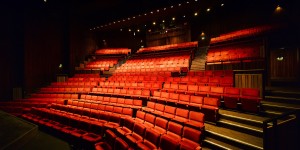
A new bridge is currently being constructed on the Liffey to link the red and green Luas lines.
The ‘extension line’ will come down Dawson Street from Stephens Green and at the end of Hawkins Street will pass over the Liffey past the front doors of The Abbey. Councillor Paddy McCartan (FG) told me ‘Connolly has a train station and a hospital named after him. I think, as the LUAS passes right past the front of the theatre, we should be pushing to call it The Abbey Bridge.’ Other suggestions from other parties include “The Tony Gregory Bridge”, “The Maeve Binchy Bridge” and “The Connolly Bridge”.
The story of The Abbey Theatre began in 1899 with the foundation of ‘The Irish Literary Theatre’ by WB Yeats, Lady Gregory, Edward Martyn and George Moore. They wanted to promote Irish writers and they staged plays in The Gaiety and The Ancient Concert Rooms which were loved by the critics but not so much by the public and sadly the company ran out of funding by 1901. The influential brothers Liam and William Fay had a crucial impact on the establishment of the national theatre. They had been touring all over Great Britain and Ireland with their repertory theatre group and when they settled back in Dublin they formed ‘W.G. Fays Irish National Dramatic Company’ in 1902. The Fays were focused on developing Irish writers and had great success with the working class of Dublin.
The Fays had experience and creativity but most importantly they were packing out halls every night, all they needed was financial backing to make it work on a permanent basis. This last financial piece of the puzzle was secured when WB Yeats worked with Annie Horniman (a tea magnate’s daughter) in London. He told her of the need for a national theatre in Dublin to promote Irish writers and Irish culture, when she received an inheritance she bought the old ‘Penny Bank’ on Lower Abbey Street. The Abbey Theatre was born in 1904.
Annie Horniman did not reside in Ireland so William Fay was appointed theatre manager in 1904. He was responsible for training actors for the newly established repertory theatre and at the same time Jack Yeats was commissioned to paint portraits of all the key people involved. On the night of King Albert’s death in May 1910 Annie Horniman requested the closure of the theatre as a mark of respect for the king. Colm O’Connor (Abbey Tour Guide) said ‘Apparently there was a telegram sent to London asking for clarification and a reply was sent back but the delivery boy didn’t arrive until after the show had started’. Angered by this lack of respect Annie Horniman ceased funding The Abbey.
In today’s money Annie was donating approximately £1 million annually, with such a dramatic loss of funding The Abbey made the decision to tour America to fundraise. Playboy of The Western World caused hysteria in New York, leading to several of the cast being arrested for a few hours which ultimately great publicity and the show was a sell-out.
It had also caused riots in The Abbey for using the term ‘shift’ which was a piece of ladies underwear, it later became known as ‘Playboy riots’. In fact the Abbey was to become no stranger to riots, when ‘Shadow of a Gunman’ was first staged it was clear from some of the dialogue that the 1916 Rising had not been socialist enough and it raised the question were we any better off? Widows of those killed in 1916 were in the audience and they were obviously insulted by this, riots ensued and the police were called.
But that just goes to show the strong connection the ordinary people of Dublin had with The Abbey. In 1925, the Abbey Theatre was given an annual subsidy by the new Free State, and the Abbey became the first ever state-subsidised theatre in the English speaking world. The State continues to support the Abbey Theatre in the form of an annual grant from the Arts Council of Ireland.
And when the building went on fire in 1951, passers-by were seen running in to save the original oil paintings in the foyer, (thanks to their bravery they hang in The Abbey today). After the fire the theatre moved to The Queens Theatre for fifteen years and in 1966 they were able to move back into their newly designed (Michael Scott was the architect) home.
The new theatre was designed to give each person a perfect sound and lighting experience, indeed the wood for the panelling was imported from Brazil and had for the times amazing acoustics. The lighting is world class and in each of the 600 seats the view of the stage is now uninterrupted.
The Abbey used to have its own scenery warehouse but with the price of storage they now rent scenery from a company in the UK and it is delivered via the backstage entrance. There are no resident actors now and haven’t been for a number of years, now a team of actors come in for one production and the schedule of plays is organised up to two years in advance.
A few months ago the Abbey purchased an adjoining building which is on the quays looking towards the Liffey. There have been numerous discussions in the media that The Abbey was going to be knocked down, or re-orientated towards the Liffey, but Colm O’Connor from The Abbey assured us they are still talking about their options and nothing has been decided. Interesting times lie ahead as we look to the future and more so than the other suggestions we feel the bridge should be named after our National Theatre as it is embedded in the psyche of people as the home of Irish Theatre.
By Joan Mitchell

